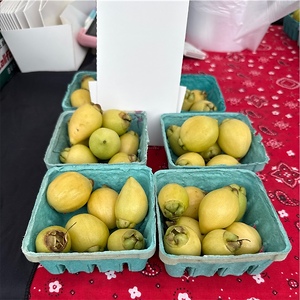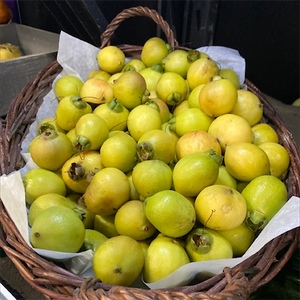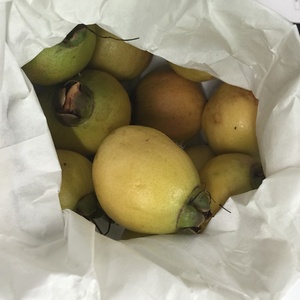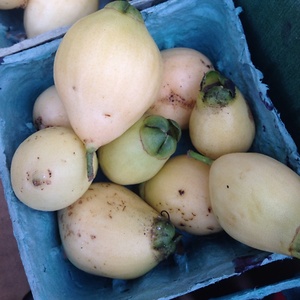

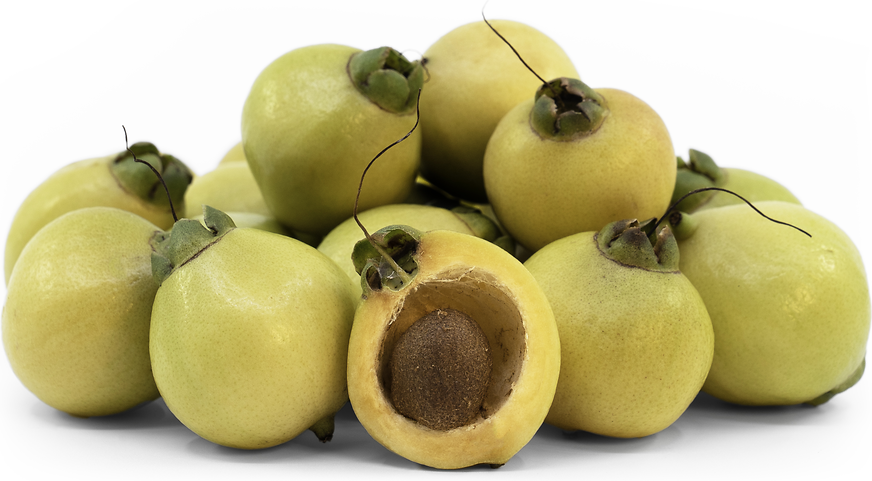
Rose Apples
Estimated Inventory, bskt : 0
This item was last sold on : 07/26/25
Description/Taste
Rose apples are small fruits, averaging 2 to 5 centimeters in diameter and 4 to 7 centimeters in length, and have a round to oval shape. The fruit is broad and curved in the center, slightly tapering to a point on the non-stem end, capped with a green fibrous calyx. Rose apples often get mistaken for guavas based on their appearance, but their flavor, fragrance, and texture are distinct. The fruit’s skin is thin, easily bruised or damaged, and has a taut, waxy, and smooth feel, ripening to muted shades of green, yellow, purple, red, and white, depending on the variety. Yellow Rose apples may also be blushed with faint spots of pink on sun-exposed sides. Underneath the surface, a thin layer of crisp, spongy, light, and watery flesh encases a hollow cavity filled with 1 to 4 rough, brown seeds. The white to pale yellow cavity has a fluffy, semi-dry coating, and the seeds eventually detach from the cavity’s walls when ripe, making a rattling noise when shaken. Rattling seeds indicate ripeness, and within the cavity, fragments of the seed coat may also be found in pieces, contributing to the subtle noise. Rose apples release an aromatic, floral scent said to smell like rose water. The fruits are edible raw and have an initially refreshing, sweet, fruity, and floral flavor followed by a subtly bitter aftertaste. Rose apples are also famous for their light, rose-like taste.
Seasons/Availability
Rose apples are available year-round in tropical climates. The fruits are typically found in the summer through fall in subtropical to temperate climates.
Current Facts
Rose apples, botanically classified as Syzygium jambos, are small, tropical fruits belonging to the Myrtaceae or myrtle family. The fruits grow in clusters on large, wide-spreading evergreen shrubs to small trees reaching 3 to 15 meters in height and are hand-harvested as a medicinal and culinary ingredient. Rose apple trees bear fruit approximately four years after planting, and a mature tree can produce around 35.57 grams of fruit in a season. Many varieties of Rose apples have naturalized throughout tropical and subtropical regions worldwide. The species is known by regional names including Pomarosa, Plum apple, and Malabar Plum in English, Yambo or Tampoy in the Philippines, Yamu-Panawa in Thailand, Lily fruit in Myanmar, Jambu Kraton or Jambu Air Mawar in Indonesia, Bogi Jamuk in Assam, Golap-Jaam in Bangladesh, Jambo in Brazil, Jambiero or Jambo Amarelo in Portuguese, and Manzana Rosa or Manzanita de Rosa in Spanish. Despite their floral moniker, Rose apples are not related to roses or apples and earned their name from their faint rose-like scent and crisp, apple-like consistency. Rose apples are primarily ornamental trees valued for their seasonal flowers and growth as a property barrier. The fruits are not commercially cultivated due to their thin, easily bruised nature and short shelf life. Rose apples are foraged from wild and home garden trees as a seasonal delicacy. The fruits are utilized for medicinal uses and are eaten fresh or cooked in a wide array of sweet and savory preparations.
Nutritional Value
Rose apples are a source of vitamin A to maintain healthy organ functioning, vitamin C to boost the immune system, and fiber to regulate the digestive tract. The species also provides potassium to balance fluid levels within the body, calcium to build strong bones and teeth, magnesium to control optimal nerve functioning, and iron to develop the protein hemoglobin for oxygen transport through the bloodstream. In traditional medicines throughout Asia, Rose apples are used as a digestive aid to cleanse the bowels and liver, which in turn leads to a cleansing of the body and mind. The fruits are also consumed as a method of hydration and immunity booster, eaten raw or made into cider vinegar. Beyond the fruits, the leaves are occasionally applied to sores and rashes, and the flowers are consumed to reduce fevers.
Applications
Rose apples have a mild, subtly sweet, fruity, and floral taste suited for raw and cooked preparations. The fruits are traditionally consumed out of hand, especially enjoyed by children as foraged snacks, and provide a refreshingly crisp, light, and watery consistency. Rose apples can also be sliced and tossed into salads, sprinkled in spiced sugar, soy sauce, or chile peppers for added flavoring, or served in fruit medleys. In addition to fresh preparations, Rose apples can be simmered into syrups, cooked into jellies, jams, and other preserves, or candied as a sweet treat. The fruits can also be used to flavor custards and puddings, stewed with sugar, or added to other various desserts. Rose apples add a rose water-type flavor when distilled and are used to flavor lemonade, cocktails, and water. The fruits can also be incorporated into savory preparations such as stir-fries and rice-based dishes. One popular preparation includes stuffing the hollow cavities of the fruit with meat or rice and baking in tomato-based sauces. Rose apples pair well with cinnamon, fruits such as mango, papaya, guava, and melon, tomatoes, tamarind, shrimp paste, garlic, chile peppers, and meats such as fish and poultry. Whole Rose apples should be immediately consumed for the best quality and flavor. The fruits bruise easily and will only keep for 2 to 4 days when stored in the refrigerator.
Ethnic/Cultural Info
Rose apple trees are a prominent plant featured in the story of Siddhartha Gautama, the well-known spiritual teacher who founded Buddhism. In the story, the young prince is sitting under the shade of the Rose apple tree while his father is attending a nearby plowing festival. Despite the noises of the celebration, Siddhartha went into a tranquil, meditative state, which was the first documented meditation. This was the first time others had witnessed Siddhartha in this state, foreshadowing his future as a spiritual leader and Buddha. The story also accounts that Siddhartha remained shaded by the Rose apple tree for hours, and the shade did not naturally move with the sun. Legend has it that the tree was embodied by a goddess who was protecting Siddhartha, and the act of shading him was meant to symbolize the feminine, nurturing elements of nature, a theme seen throughout the story of Buddhism.
Geography/History
Rose apples are native to regions of Southern and Southeastern Asia, mainly India, Nepal, Malaysia, and the Philippines, and have been growing wild since ancient times. The species naturally spread through human and animal expansion, and the shrubs to small trees quickly naturalized throughout the Pacific Islands, Reunion Island, and other tropical regions. In 1762, the species was introduced to Jamaica, later spreading into Mexico, Bermuda, the Bahamas, and parts of Central and South America. Rose apples were also planted in Florida around 1877 and were eventually sown in California and Hawaii. Today, Rose apples thrive in tropical to subtropical climates with well-draining soil and moist, warm regions. The plants typically grow between 600 and 2,300 meters in height and are naturally found along canals, river banks, streams, and other bodies of water. The species is found on every continent except for Antarctica and is planted in home gardens as a landscape ornamental. When in season, Rose apple fruits are foraged and gathered from garden trees as a delicacy for fresh markets worldwide.
Recipe Ideas
Recipes that include Rose Apples. One
| Beyond Sweet and Savory |
|
Hidden Rose Apple Tart |



